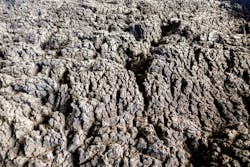EPA awards nearly $6M for research on pollutants found in biosolids
The U.S. Environmental Protection Agency (EPA) recently announced $5,976,976 in funding to four institutions for research to support states, municipalities, and utilities in determining the potential risks to human health and the environment from pollutants found in biosolids, also known as treated sewage sludge. Results from this research may inform the development of standards and policies for biosolids management.
“It is important that municipalities and utilities have the information they need to treat and manage biosolids,” said Wayne Cascio, acting assistant administrator for science in EPA’s Office of Research and Development. “These grants will help us leverage resources and knowledge to ensure the latest science is being used to protect public health and the environment.”
Biosolids are created during the wastewater treatment process. When biosolids are applied to land, they add nutrients, improve soil structure and enhance moisture retention. Applying biosolids to land has economic and waste management benefits since it saves space in landfills, recycles a waste product, and reduces demand for synthetic fertilizers.
However, biosolids can also contain a variety of pollutants. Utilities and states need information on these pollutants to ensure that they are processed, handled, and used in a way that minimizes potential harm. To address these needs, the researchers receiving these grants will seek new information on the occurrence, fate and transport of chemicals in land-applied biosolids, as well as the impact of various treatment and management processes on chemical levels in biosolids.
The following institutions are receiving research grants:
- Johns Hopkins University, Baltimore, Md. – to use analytical, toxicological, and risk sciences tools to identify previously unknown biosolids-associated organic contaminants, trace their fate through multiple environmental media, and prioritize them for future decision-making.
- Michigan State University, East Lansing, Mich. – to improve knowledge of occurrence, transport, fate, plant uptake, livestock, and human exposure to pollutants in land-based biosolids including pharmaceuticals, personal care product residues and per- and polyfluoroalkyl substances (PFAS).
- Virginia Institute of Marine Science, Gloucester Point, Va. – to evaluate the influence of wastewater source and treatment choice on pollutants in sludge to improve strategies for monitoring sludge-related pollutants, select optimal treatment processes and reduce contaminate levels in U.S. biosolids and receiving soils.
- The Water Research Foundation, Denver, Colo. – to conduct studies and use the data to evaluate fate and transport models in risk assessments, leading to recommended best practices to reduce or manage potential risks of unregulated organic chemicals in biosolids-amended fields.
More information on these awards: https://cfpub.epa.gov/ncer_abstracts/index.cfm/fuseaction/recipients.display/rfa_id/675/records_per_page/ALL
More information on EPA research grants: https://www.epa.gov/research-grants
